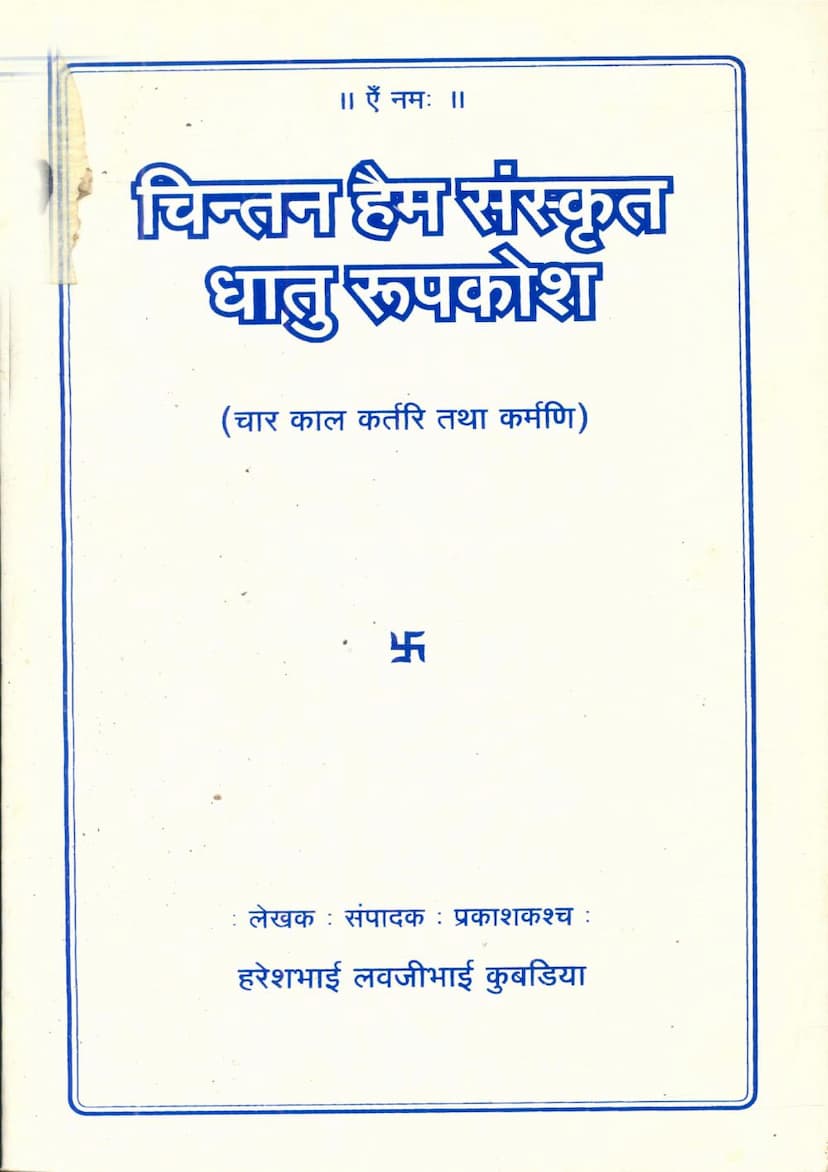Chintan Haim Sanskrit Dhatu Rupkosh
Added to library: September 1, 2025

Summary
Here is a comprehensive summary of the Jain text "Chintan Haim Sanskrit Dhatu Rupkosh" by Haresh L Kubadiya:
Book Title: Chintan Haim Sanskrit Dhatu Rupkosh (चिन्तन हैम संस्कृत धातु रूपकोश) Author/Editor/Publisher: Haresh L Kubadiya (हरेश लवजीभाई कुबड़िया) Publisher Location: Palitana, Gujarat, India Publication Year: Samvat 2060 Veer Samvat 2530, E. San. 2004 Edition: Second Edition (आवृत्ति - द्वितीय), Print Run 2000 copies
Overview:
"Chintan Haim Sanskrit Dhatu Rupkosh" is a specialized lexicon and grammatical resource focused on Sanskrit verb roots (Dhatu) and their various conjugations. The title translates to "Contemplation-Gold Sanskrit Verb Root Lexicon." The book's subtitle, "Four Tenses in Active and Passive Voices" (चार काल कर्तरि तथा कर्मणि), clearly indicates its primary focus on presenting the complete conjugational paradigms of Sanskrit verbs across four key tenses (Lars) in both the active (Kartari) and passive (Karmani) voices.
Key Content and Structure:
The book is systematically organized to provide a comprehensive guide to Sanskrit verb forms. Based on the "Anukramanika" (Table of Contents), the structure includes:
- Categorization by Verb Class (Gana): Sanskrit verb roots are traditionally classified into ten Ganas (classes). The Rupkosh appears to follow this classification, detailing verbs within each Gana.
- Per-pada (Parasmaipada) and Atmanepada: Within each Gana, verbs are further categorized based on whether they belong to the Parasmaipada (ending in -ti, -ti, etc., generally taking direct objects) or Atmanepada (ending in -te, -te, etc., generally for the benefit of the subject). Some Ganas also include Ubhaya-pada verbs that can conjugate in both.
- Detailed Conjugations: For each verb root, the book meticulously lists its forms across the four primary tenses:
- Lart (Present Tense): Including active (Kartari) and passive (Karmani) conjugations.
- Lat (Past Tense): Likely covering various past tenses.
- Lot (Imperative Mood): For commands and requests.
- Lrut (Future Tense): For future actions.
- Specific Sections: The book also includes:
- Krdant-Parishishta (Appendices on Krdanta): Sections related to derived verbal nouns and participles.
- Karmani Parivartana (Transformation to Passive): Instructions and examples on converting active voice forms to passive.
- Upayog Nirdesh (Usage Instructions): Guidance on how to use the verb forms correctly.
Purpose and Target Audience:
This lexicon is a valuable tool for students and scholars of Sanskrit, particularly those interested in the intricacies of Vedic and Classical Sanskrit grammar. Its detailed presentation of verb conjugations aims to facilitate:
- Accurate Verb Usage: Helping users to correctly form and understand Sanskrit verbs in various contexts.
- Grammatical Understanding: Providing a deep dive into the declension and conjugation patterns of Sanskrit verbs.
- Literary and Scriptural Study: Enabling better comprehension of Jain Agamas, philosophical texts, and classical Sanskrit literature, many of which are listed as areas of study by the author on page 3 (e.g., Trishashti Shalaka Purush Charitra, Tattvartha Sutra commentaries, Meghaduta, Raghuvansha, etc.).
Author's Background and Dedication:
Haresh L Kubadiya is presented as the author, editor, and publisher, indicating a dedicated effort in compiling this work. The book is associated with prestigious Jain institutions: Shri Vijay Kesarsurishwarji Syadwad Vidyamandir and Shri Bheermal Mahavideh Dham. The work is also inspired by the teachings and guidance of various respected Jain monks (Acharyas and Sadhus), as mentioned on pages 4 and 5, highlighting a strong connection to Jain religious and educational traditions. The author also emphasizes his expertise in ancient scripts for those interested in studying them.
Significance:
The "Chintan Haim Sanskrit Dhatu Rupkosh" serves as a practical and scholarly resource for mastering Sanskrit verb conjugations, a fundamental aspect of the language. Its comprehensive approach, covering multiple tenses and voices across various verb classes, makes it a significant contribution to Sanskrit grammatical literature, especially within the Jain tradition. The author's explicit instruction for "Jain disciples to use this book for study" (Page 3: "આ પુસ્તક જ્ઞાન ખાતાની હોઈ શ્રાવકે ઉપયોગ રાખી અધ્યયન કરવું.") underscores its intended role in Jain education.